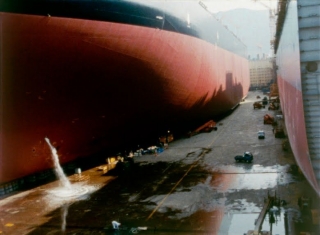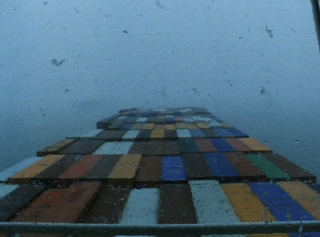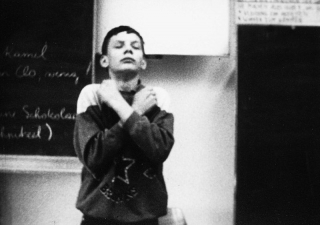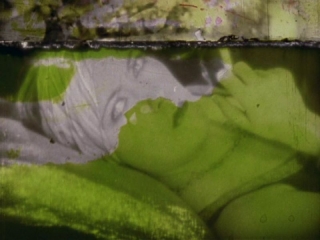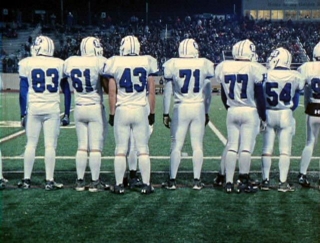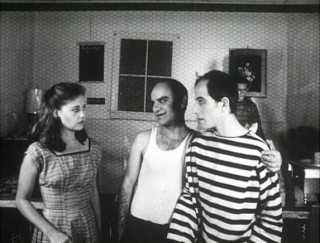Date: 2 November 2010 | Season: Plenty
PLENTY 1: THE END
Tuesday 2 November 2010, at 7pm
London E:vent Gallery
The screening series PLENTY proposes a new way of looking at artists’ films by showing only a single work, regardless of its duration. Each film is given the freedom to unfold on its own terms, and the viewer is given the time and space to consider it.
“Ladies and gentlemen. We asked you before to insert yourself into the cast, now we ask you to write this story. Here is a character. Here is the most beautiful music on earth. Here are some pictures. What is happening?”
THE END
Christopher Maclaine, USA, 1953, 16mm, b/w & colour, sound, 35 min
The End follows the last day on earth for six of ‘our friends’ living in the shadow of the atomic bomb. Cryptic camerawork and disjointed cutting conspire to salvage narrative from unrelated images, accompanied by a barely coherent rant of existential despair. The End is an anti-film infused with dark, ironic humour; deliciously inept and inadvertently glorious.
Christopher Maclaine (1923-75) was a marginal figure in the early beatnik scene of North Beach, San Francisco. He wrote poetry and prose, and made four films. Maclaine’s heavy use of amphetamines ultimately rendered him debilitated, resulting in hospital internments and early death.
PLENTY, a free monthly screening series selected by Mark Webber, forms part of the “Brief Habits” programme curated by Shama Khanna.
Date: 11 November 2010 | Season: Films of the Sea, Writings
PETER HUTTON’S SEA STORIES
Published on the occasion of “Films of the Sea” at Fondazione Morra, Naples, 11—12 November 2010.
Filmmaker Peter Hutton recounts an early experience as a merchant seaman, and its sustained influence on his practice, as told to Mark Webber on 25 November 2007.
I grew up just outside Detroit and there was series of travelogues shown regularly at the Detroit Art Institute. At that time it was somewhat common for people to make 16mm films about their travels to Europe or to South America, or even to State Parks in America, and they would put together these little films. Of course, when I was young I didn’t think that I would have any relationship to film but these were some of the first more personal film experiences I had. It’s kind of interesting because essentially what I’ve been doing are sorts of travelogues as well, records of my own wandering around the world. My father had been a great traveller as a young man. He also worked as a merchant seaman for a couple of years, not as long as I did, but he got in touch with a certain degree of wanderlust.
Initially I went to sea working on the Great Lakes of the USA. I had these amazing dreams of going to Shanghai and Alexandria and exotic ports around the world, but there I was in the Great Lakes going to Cleveland and Toledo and Ashtabula and these funky mid-western coal towns. I worked there for about four months, saved up some money and then moved to Honolulu. I knew Honolulu was a great port to get a ship, particularly for going to the Far East.
I spent three or four years in Hawaii during the early 1960s, shipping out and also taking classes at the University of Hawaii, which was also very important to me as an artist. Concurrent with my art school education was being exposed to the beauty and the wonder of being at sea. The first and most profound trip I took was from Hawaii to India. Within two weeks of moving to Honolulu I boarded a ship headed for Calcutta – I was just 19 years old and I was never quite the same after that trip; it was the one that really turned my head around in some bigger way.
I actually spent a month there because the ship was damaged and we had to repair it so we just stayed in port. They had to reconfigure the whole propeller because it had been bent. Most the crew moved into fleabag hotels in town, and I remember hiring a young Indian guy to do my work on the ship. Technically, I still had to report to the ship every day and do the midnight to 4 a.m. watch. I hired some Indian guy, as all the crew did, paid him probably a one hundredth of what I was getting paid, and he would do my job while I would wander around Calcutta. That in itself was a life-changing event for me. The most intense visual experience I had during that time was when the company decided to paint the ship while it was being repaired.
This is a very Conradian kind of story of my first ship in the Pacific. The ship had left Tacoma, Washington, and made it as far as Guam in the Pacific when one of the boilers blew up so they towed the ship to Honolulu. The entire crew disembarked and they were repairing the boiler. That’s when I was hired to go on the ship, it was a kind of a wounded beast. I remember walking into the Union Hall for my first encounter with the union people, and the guy said, “Hey kid, you want to go Calcutta?” And I just thought, “Oh my god, this is what I’ve been dreaming about!” So I get down to the ship and I realise it’s a very old ship that has this cargo of wheat all battened down in the holds. I was on board for maybe two weeks in port before we set sail because they couldn’t get a crew together; they were having a hard time getting enough people to man the ship.
Finally when we set sail for India, I realised that it was a pretty dysfunctional crew – a lot of druggies, a lot of alcoholics – it was the most colourful, motley group of characters you could imagine. This made the trip all the more interesting for me, but essentially by the time we got to Calcutta and opened the hatches, the wheat had rotted inside the holds. It was a gift from the US Government to the Indian Government, and it was this supremely decayed cargo of wheat. It was rancid. I remember being amazed by how stinky Calcutta was to begin with; there was this fetid atmosphere in an area called Khidirpur on the waterfront. It was like we were sailing into the asshole of the world, the most violent odour I had ever encountered. Then when they popped open the ship it was even worse: the wheat.
Somehow every kernel of that wheat had to be taken off the ship, and essentially something like three of four hundred men came on board. They would go down into the holds and fill gunny sacks with the wheat, sew them up and then carry them off on their backs. It was an amazing procession, like an ant colony of humans sort of overtaking the ship to unload the cargo. Concurrent with that were several hundred men with little hammers, hanging over the sides of the ship on ropes, chipping the paint off. They were also painting the engine room, so the ship was just inundated with humanity. The impression of seeing that has stayed with me for my whole life; it was the most amazing symphony of humanity and atmosphere. This was an image that I’ll never forget, and I think that memory somewhat foreshadows At Sea, the more recent film about ships. That whole sequence of the film which is shot in Bangladesh, these little guys working on these big ships, is in some way trying to reference or recapture that first experience of being in Calcutta.
These extracts are taken from an interview conducted by Mark Webber for a forthcoming oral history of avant-garde film. Initial research for the project was funded by the British Academy.
Date: 11 November 2010 | Season: Films of the Sea
FILMS OF THE SEA: 1
Thursday 11 November 2010, at 8pm
Naples Fondazione Morra
In all of the arts, the ocean has been a constant source of inspiration, from Hokusai to JMW Turner, or from ‘Moby Dick’ to ‘Titanic’. As an emblem of endless possibilities, it might lead to discovery or tragedy, new lives or lives lost. These seven films are ‘of the sea’ in that they draw inspiration from it, but they are far from straightforward depictions. Peter Hutton, a former merchant seaman, has made many films of ships and seascapes. His most recent and most celebrated is At Sea, which traces the life cycle of massive container ships. David Gatten made his abstract film without a camera, by submerging unexposed lengths of film in the ocean. The second programme seeks out narrative through tall tales and maritime folklore. Slipping between dreams and reality, it includes the surreal (Maya Deren), the erotic (Matthias Müller) and childhood fantasy (Janie Geiser). Mati Diop follows a stowaway from Africa to Europe, and Rebecca Meyers explores the perils of seafaring off the American coast. “What the sea wants, the sea will have.”
Peter Hutton, At Sea, USA, 2007, 60 min
David Gatten, What the Water Said Nos 4-6, USA, 2006, 17 min
Curated by Mark Webber for the Independent Film Show 10th Edition
PROGRAMME NOTES
AT SEA
Peter Hutton
2007, USA, 16mm, colour, silent, 60 min
“Peter Hutton has modestly spoken of his work as being ‘a little detour’ from the history of cinema but perhaps he is following a path that others have neglected, or are yet to discover. Typified by fixed shots of extended duration, his concentrated gaze builds a bridge between early cinema, landscape painting and still photography, evoking Lumière, Turner and Stieglitz. Hutton’s camera often records the subtle changes of light and atmospheric conditions of rural and urban locations, and has frequently been directed toward nautical themes. This new film is essentially about the birth, life and death of large merchant ships. Following the construction of the vessels in South Korea and the passage of a massive container ship across the North Atlantic, it ends with images of shipbreaking in Bangladesh. At Sea is a real tour-de-force, in which the weight and scale of its subject is conveyed by masterful cinematography over a series of breathtaking compositions.” (Mark Webber)
WHAT THE WATER SAID, NOS 4-6
David Gatten
2006, USA, 16mm, colour, sound, 17 min
“What the water said is literally inscribed on the strips of unexposed celluloid that Gatten cast into the Atlantic Ocean off the coast of South Carolina. Encased in crab traps, the fragmented filmstrips harbour mystical messages from the underwater world, a source of seemingly never-ending fascination. The sea, its salt, sand and rocks, and its gnawing creatures have created the film’s inimitable textured patterns and sounds, while passages from Western literature’s greatest sea odysseys – from ‘The Life and Adventures of Robinson Crusoe’ to ‘Moby Dick’ – remind us of the sea’s singular place in our imagination.” (Andréa Picard)
Back to top
Date: 12 November 2010 | Season: Films of the Sea
FILMS OF THE SEA: 2
Friday 12 November 2010, at 8pm
Naples Fondazione Morra
In all of the arts, the ocean has been a constant source of inspiration, from Hokusai to JMW Turner, or from ‘Moby Dick’ to ‘Titanic’. As an emblem of endless possibilities, it might lead to discovery or tragedy, new lives or lives lost. These seven films are ‘of the sea’ in that they draw inspiration from it, but they are far from straightforward depictions. Peter Hutton, a former merchant seaman, has made many films of ships and seascapes. His most recent and most celebrated is At Sea, which traces the life cycle of massive container ships. David Gatten made his abstract film without a camera, by submerging unexposed lengths of film in the ocean. The second programme seeks out narrative through tall tales and maritime folklore. Slipping between dreams and reality, it includes the surreal (Maya Deren), the erotic (Matthias Müller) and childhood fantasy (Janie Geiser). Mati Diop follows a stowaway from Africa to Europe, and Rebecca Meyers explores the perils of seafaring off the American coast. “What the sea wants, the sea will have.”
Maya Deren, At Land, USA, 1944, 14 min
Matthias Müller, Sleepy Haven, Germany, 1993, 14 min
Janie Geiser, Kindless Villain, USA, 2010, 4 min
Mati Diop, Atlantiques, France/Senegal, 2009, 15 min
Rebecca Meyers, Blue Mantle, USA, 2010, 35 min
Curated by Mark Webber for the Independent Film Show 10th Edition
PROGRAMME NOTES
AT LAND
Maya Deren
1944, USA, 16mm, black and white, sound, 14 min
“In At Land, a woman (Deren) emerges from the ocean and infiltrates various social situations, including a dinner party and a chess game on the beach. Her emergence and ensuing sojourns among jarring geographies highlight the film’s key device – editing. The film casts the protagonist adrift in hostile social and natural environments but provides the character with the means to survive the inhospitable worlds she navigates – a multiplication of herself that produces sameness and difference. At Land is Deren’s least personal yet most individualistic film – ignored by many characters in the film, the protagonist is recognised and affirmed only by increasingly abstract, depersonalised, and spatially displaced versions of herself.” (Maria Pramaggiore)
Sleepy Haven
Matthias Müller
1993, Germany, 16mm, colour, sound, 14 min
“Sleepy Haven’s mottled, fissured surfaces resemble nothing so much as a body, its solarized apertures imparting a hallucinatory beauty which threatens always to break apart entirely, the skin of its material support pitilessly stretched across their fantastical recline. Asleep, the bodies offer themselves up to the gaze of the beholder, the film’s daydream structure suggesting that their minds are elsewhere, drifted far from these emptied tissues and ligaments, the better to offer themselves as vehicles of fantasy and projection. The long dream of the image world, depicted here as a reverie in stasis, a sleepy haven, is both conjured and deconstructed, made to reveal the stress fractures which result when the aims of everyday life are made to rub up against the dream factory.” (Mike Hoolboom)
Kindless Villain
Janie Geiser
2010, USA, video, black and white, sound, 4 min
“In Kindless Villain, two boys wander through a stone fortress while battles wage in the waters beyond. Seemingly alone in their island world, they succumb to fatigue and to boys’ games of power. Scratched phrases from an ancient recording of Hamlet surface, including a sad cry for vengeance. War is a child’s game, played quietly in this forgotten world.” (Janie Geiser)
Atlantiques
Mati Diop
2009, France/Senegal, video, colour, sound, 15 min
“Sitting by the campfire, a boy from Dakar named Serigne tells his two friends the story of his sea voyage as a stowaway. Not only he, but everyone in his surroundings seems to be continually obsessed by the idea of trying to cross the sea. His words reverberate like a melancholy poem. A story about boys who are continually travelling: between past, present and future, between life and death, history and myth.” (Mati Diop)
Blue Mantle
Rebecca Meyers
2010, USA, 16mm, colour, sound, 35 min
“Blending 19th century American literature with factual accounts, illustrations and music by Debussy and Wagner, this oblique portrait of a shipwrecked coastline conveys the vastness and majesty of the ocean. A song to the sea, and a commemoration of those who have risked their lives off the treacherous Massachusetts shore.” (Mark Webber)
Back to top
Date: 30 November 2010 | Season: Plenty
PLENTY 2: ÄGYPTEN
Tuesday 30 November 2010, at 7pm
London E:vent Gallery
The screening series PLENTY proposes a new way of looking at artists’ films by showing only a single work, regardless of its duration. Each film is given the freedom to unfold on its own terms, and the viewer is given the time and space to consider it.
ÄGYPTEN [EGYPT]
Kathrin Resetarits, Austria, 1997, 16mm, b/w, sound, 10 min
Ägypten takes viewers on a journey into the silent world of sign language, exploring visual communication between people of all ages. Children recount movie scenes and an expedition to the pyramids, a woman signs a traditional Viennese ballad and a group of pensioners socialise. The film uses the power of cinema to explore this theme with humour and compassion.
Kathrin Resetarits (born 1973) is a Viennese writer, actress and filmmaker. Her other films include Fremde (1999) and Ich Bin Ich (2006). She played a leading role in Barbara Albert’s Fallen (1997) and has worked as an assistant to Michael Haneke.
PLENTY, a free monthly screening series selected by Mark Webber, forms part of the “Brief Habits” programme curated by Shama Khanna.
Date: 11 January 2011 | Season: Plenty
PLENTY 3: COCULLO
Tuesday 11 January 2011, at 7pm
London E:vent Gallery
The screening series PLENTY proposes a new way of looking at artists’ films by showing only a single work, regardless of its duration. Each film is given the freedom to unfold on its own terms, and the viewer is given the time and space to consider it.
COCULLO
Nino Pezzella, Italy, 2000-06, 16mm, colour, sound, 30 min
Snakes alive! For the annual Festa dei Serpari in Cocullo, a statue of San Domenico is adorned with snakes and paraded through the village streets, escorted by bagpipes and a marching band. Traditional foods are prepared using time-honoured methods. Pezzella’s dynamic film collides sounds and images as it follows this extraordinary ritual and its participants.
Painter and filmmaker Nino Pezzella (born 1961, Wiesbaden) studied at the Städelschule, Frankfurt, where he now teaches life drawing. His current work documents the lives of the Femminielli in Naples.
PLENTY, a free monthly screening series selected by Mark Webber, forms part of the “Brief Habits” programme curated by Shama Khanna.
Date: 8 February 2011 | Season: Plenty
PLENTY 4: BARBARA’S BLINDNESS
Tuesday 8 February 2011, at 7pm
London E:vent Gallery
The screening series PLENTY proposes a new way of looking at artists’ films by showing only a single work, regardless of its duration. Each film is given the freedom to unfold on its own terms, and the viewer is given the time and space to consider it.
BARBARA’S BLINDNESS
Joyce Wieland & Betty Ferguson, Canada, 1965, 16mm, b/w, sound, 17 min
Constructed from found and stock footage, Barbara’s Blindness is a meditation on vision and adversity, drawing humour and pathos from a moralising educational film. “We started out with a dull film about a little blind girl named Mary and ended up with something that made us get crazy.”
Joyce Wieland (1931-88) was a pioneer of patriotic and feminist Canadian art. Though primarily known as a filmmaker, she was also a distinguished painter and mixed media artist. Wieland’s lifelong friend Betty Ferguson (born 1933) went on to make three found footage films of her own in the 1970s.
PLENTY, a free monthly screening series selected by Mark Webber, forms part of the “Brief Habits” programme curated by Shama Khanna.
Date: 8 March 2011 | Season: Plenty
PLENTY 5: O’ER THE LAND
Tuesday 8 March 2011, at 7pm
London E:vent Gallery
The screening series PLENTY proposes a new way of looking at artists’ films by showing only a single work, regardless of its duration. Each film is given the freedom to unfold on its own terms, and the viewer is given the time and space to consider it.
O’ER THE LAND
Deborah Stratman, USA, 2009, 16mm, colour, sound, 52 min
Marine Corps pilot William Rankin ejected from his jet into a severe thunderstorm, surviving lightening strikes in a 40-minute descent. 50 years later, his account is the starting point for a contemplation of American national identity that takes in Civil War re-enactments, high school football games, gun shows, firefighters and border patrols.
Deborah Stratman (born 1967) is a Chicago-based artist working in photography, sound, drawing and installation. Her films use experimental and documentary techniques to explore an interest in landscapes, mythologies and systems.
PLENTY, a free monthly screening series selected by Mark Webber, forms part of the “Brief Habits” programme curated by Shama Khanna.
Date: 14 March 2011 | Season: Miscellaneous | Tags: Gregory Markopoulos
IN FOCUS: GREGORY MARKOPOULOS
Tuesday 8 March 2011, at 7pm
Gent Cinema OFFoff
Gregory J. Markopoulos (1928-1992) groeide op in Toledo, Ohio, als kind van Griekse immigranten, maar keerde terug naar Griekenland in 1967. Na twintig jaar films maken in de Verenigde Staten besloot hij vanuit zijn idealistische visie op de artistieke en professionele onafhankelijkheid van de filmmaker en het kunstencircuit om zijn films samen te brengen in het Temenos Film Project. Daarin volgde hij zijn eigen koers in de ontsluiting van zijn oeuvre samen met zijn partner, de filmmaker Robert Beavers. OFFoff vertoont tijdens de maand maart drie programma’s gecompileerd door Temenos. Het eerste luik bevat de volgende kortfilms: Swain(1950), die eerst de titel Rain Black My Love droeg en waarin de regisseur zelf de protagonist is, Flowers of Asphalt (1951) die footage bevat uit iets vroeger werk, met name Jackdaw (1950) en Christmas USA (1949), de stille film Eldora (1953) en tot slot het beroemde Twice A Man (1963). Deze sensuele film, met muziek van Tchaikovsky, is gebaseerd op de mythe van de aseksuele Hippolytos, die ten val kwam met zijn paard door de grillen van jaloerse goden. Markopoulos beoogde een uitgepuurd evenwicht tussen narratie, montage, mise-en-scène, en geluid. Zijn consequente esthetisme en de psychodramatische geladenheid van zijn films maken dat hij een unieke status bekleedt binnen de geschiedenis van de Amerikaanse avant-garde.
Gregory Markopoulos, Swain, USA, 1950, 16mm, colour, sound, 24 min
Gregory Markopoulos, Flowers of Asphalt, USA, 1951, 16mm, b/w, silent, 7 min
Gregory Markopoulos, Eldora, USA, 1953, 16mm, colour, silent, 8 min
Gregory Markopoulos, Twice a Man, USA, 1963, 16mm, colour, sound, 48 min
Deze screening wordt ingeleid door onafhankelijk filmcurator Mark Webber. Webber presenteert het oeuvre van Markopoulos wereldwijd. Op dit moment voltooit hij zijn boek Film as Film: The Collected Writings of Gregory J. Markopoulos dat volgend jaar zal verschijnen. Hij nam het curatorschap op zich van screenings en tentoonstellingen van onder meer Andy Warhol, Robert Beavers, Owen Land en de London Filmmakers Co-op en was gastcurator voor het BFI London Film Festival.
Met dank aan Robert Beavers (Temenos).
Date: 5 April 2011 | Season: Miscellaneous | Tags: London Lesbian & Gay Film Festival
THE FORGOTTEN FILMS OF CHARLES LUDLAM
London Lesbian & Gay Film Festival 2011
Tuesday 5 April 2011, at 6:20pm
London BFI Southbank NFT2
These two re-discovered films by Charles Ludlam, legendary leader of the Ridiculous Theatrical Company, are affectionate gender-bending homages to the golden age of silent cinema. Contemporary with John Vaccaro and Jack Smith, Ludlam also broke the mould by bringing hysterical high camp, satire and melodramatic parody to the New York stage. Works-in-progress for over a decade, the films were left unfinished at the time of his death in 1987 and have now been digitally restored by his friends and admirers.
THE SORROWS OF DOLORES
Charles Ludlam, USA, 1987, 80 min
with Everett Quinton, Minette, Arthur Kraft
Ludlam’s lover Everett Quinton plays a hapless creature who, having witnessed the abduction of the Gorilla Girl from a carnival freak show, is hoodwinked into white slavery and ravaged by King Kong. Failing to find her salvation in a convent, Dolores makes her fortune in a bordello before realising there’s no place like home.
MUSEUM OF WAX
Charles Ludlam, USA, 1987, 21 min
with Charles Ludlam, Everett Quinton, Debbie Pettie
This rarely seen treasure stars Charles Ludlam as an escaped prisoner who seeks refuge in an eerie Coney Island sideshow.

